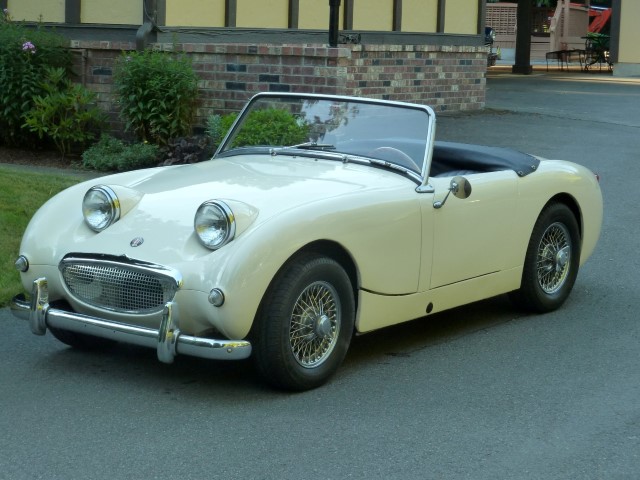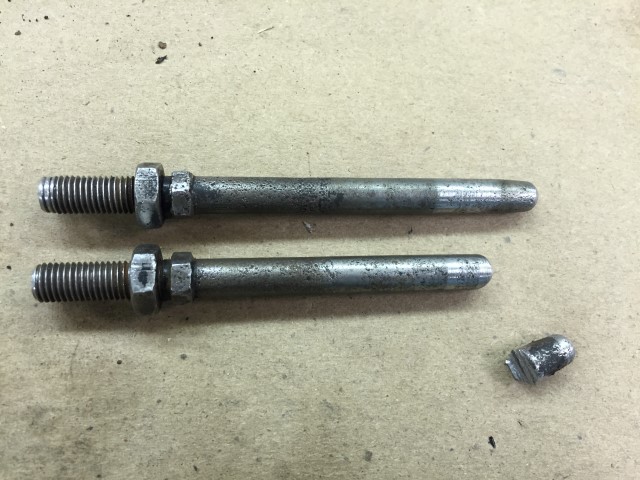

While this isn't much of a project, it includes some information I've learned about Datsun 5-speed conversions to a Sprite. I'm including this since it might help others researching the same conversion.
Here's my Bugeye Sprite, I've had it for a lot of years, originally buying it in Austin Texas and driving it home over the Rockies back to the Seattle area. I've had several through the years, the first one which I bought for $200 in 1968. They just get into your system.

Sprites like this are the picture of simplicity. To save costs, there is no trunk (boot) lid, no outside door latches, or no roll-up windows. But, they are nimble, fun to drive, economical, relatively reliable, and have features unusual for the time (Bugeyes were built from '58-'61) such as unibody construction and rack-and-pinion steering. In Europe and the UK, they are called Frog-Eye Sprites.
These cars, from the factory, only have 43 HP from a 948cc Austin motor. But then, since they only weigh 1440 lbs, they don't need a lot. Before I bought it, it was converted to a 1275 cc Austin motor from a later Sprite, which is a bolt-in operation, and gives it a few more beans for keeping up with traffic. However, the original transmission has no synchro in first, is fragile, and has a 1:1 top gear. This leads to high RPM cruising - 4,000 RPM at 60 MPH.
A Datsun 210 5-speed conversion gives it synchro in first and an nice overdrive 5th gear for more relaxed cruising. I opted for the Rivergate kit which includes the parts to make it bolt in. The Rivergate folks offer a slave-cylinder with a larger diameter than the stock Datsun slave cylinder to make the clutch work better after the transplant, so I used one of those. Factory Datsun is 3/4", and the one offered by Rivergate is 7/8".
However, while satisfied with the conversion in general, I found the clutch still hard to press and regulate for smooth operation. After talking to the Rivergate folks (very nice people), I found that the later Sprites, the ones with disk brakes on the front, have a master cylinder with a smaller bore than the original master cylinder. 3/4" diameter, vs the original 7/8" diameter. This gives you about 36% better leverage on both the brakes and clutch.
I installed one of these later master cylinders, and while it solved the hard clutch issue, I had a great deal of difficulty making the adjustments for proper operation, and also to let the fluid bleed back into the master cylinder so the brakes don't start to bind when warm.
After some research, I found that these later master cylinders had push-rods that are a full 1/2" shorter than the earlier ones. When I shortened those, all the pieces fell into place and the clutch and brake operation is much improved now!

Here's a shot of the two push-rods, with one of them shortened. They start out at 4-3/16" long, and need to be shortened to 3-11/16" long.
In a couple other projects (Model-A hydraulic brake conversion and MG-J2 build), I've installed single chamber brake master cylinders, and had folks email me about the safety of not having dual chambers like modern cars. Well, I guess I grew up in an era of single chambers, so don't worry about it that much. However, these Sprites (and MG Midgets, or Spridgets) take that one step further by having a single chamber for both brakes and clutch. So, if you lose either hydraulic system, you lose both. But, I can say from experience that you can get home when this happens. Put it in first, then fire up the engine to get going, then carefully shift up and down with double-clutching. When time comes to stop again, put it in neutral and use the park brake. Just make sure you keep yourself from having to make fast stops.
One more thing about these 210 transmissions: They are getting tough to find lately, and you might be prone to rebuild it, or have that done. Rebuild kits are still available (hard to find sometimes), but those I've seen that are still available don't have synchronizer rings that are perfect for this application. I've had one transmission rebuilt professionally, and rebuilt another myself, and found that in both cases, the synchro action wasn't much better than before the rebuild. So - if your transmission is pretty good - don't assume that it will be better after a rebuild!
I hope this information about sizing of the master and slave cylinders, and the necessity of shortening the push-rods will be useful information for you, should you be doing the same conversion.